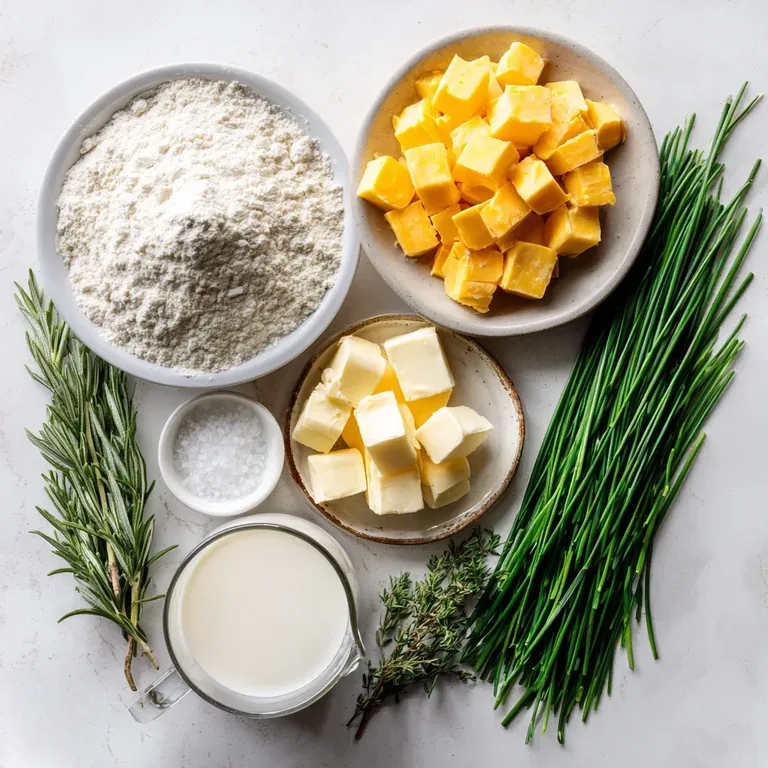Imagine pulling a tray of golden‑brown scones from the oven, their tops speckled with melted cheese and fragrant herbs. The aroma alone convinces anyone within sniffing distance that something special is about to happen.
What sets these Savory Herb and Cheese Scones apart is the perfect marriage of flaky pastry with a burst of fresh garden flavors. A blend of sharp cheddar, nutty parmesan, and a trio of herbs creates depth without overwhelming the delicate crumb.
Ideal for brunch, a tea‑time snack, or a side to a hearty soup, these scones will delight both cheese lovers and herb enthusiasts alike. They’re equally at home on a casual family table or as an elegant addition to a cocktail party platter.
The process is straightforward: combine dry ingredients, cut in cold butter, fold in cheese and herbs, then finish with a quick brush of egg wash before baking at a high heat. In just under half an hour you’ll have a batch of irresistible, tender scones ready to share.
Why You'll Love This Recipe
Bold, Balanced Flavor: The sharpness of cheddar, the nuttiness of parmesan, and the bright notes of chives, thyme, and parsley create a harmonious bite that keeps you reaching for more.
Effortless Technique: With just three simple steps—mix, fold, bake—this recipe is perfect for novice bakers and seasoned cooks who crave speed without sacrificing quality.
Versatile Serving Options: Serve warm with butter, pair with a dollop of sour cream, or break them up for a crunchy topping on soups and salads.
Make‑Ahead Friendly: Bake a batch ahead of time, store them properly, and reheat for a quick snack that tastes freshly baked any day of the week.
Ingredients

For truly flaky scones, the balance of cold butter, high‑protein flour, and a touch of dairy is essential. The cheeses provide richness while the fresh herbs inject a garden‑bright finish. A light egg wash gives the tops a beautiful golden sheen, and a splash of milk keeps the interior tender. Together these components create a savory pastry that’s both sturdy enough to hold toppings and delicate enough to melt in your mouth.
Dry Ingredients
- 2 cups (250 g) all‑purpose flour
- 2 teaspoons baking powder
- ½ teaspoon fine sea salt
Cheese & Herbs
- 1 cup (100 g) sharp cheddar, grated
- ½ cup (50 g) parmesan, finely grated
- 2 tablespoons fresh chives, minced
- 1 tablespoon fresh thyme leaves
- 1 tablespoon fresh parsley, chopped
Wet Ingredients
- ½ cup (120 ml) whole milk, chilled
- ¼ cup (60 ml) heavy cream
- 1 large egg, lightly beaten
- ¼ cup (60 g) unsalted butter, cold and cubed
The cold butter pieces create steam pockets as they melt, giving the scones their signature flaky layers. Milk and cream add moisture and a tender crumb, while the egg wash encourages a glossy, lightly crisp crust. The combination of three herbs ensures every bite bursts with freshness, and the duo of cheeses delivers a savory depth that keeps you reaching for another.
Step-by-Step Instructions

Preparing the Dry Base
Begin by whisking together the flour, baking powder, and sea salt in a large mixing bowl. This ensures an even distribution of leavening, which is crucial for a uniform rise. Once combined, set the bowl aside while you work on the butter—keeping everything cold will guarantee the scones stay light and airy.
Incorporating Butter
Add the cold, cubed butter to the dry mixture. Using a pastry cutter, two forks, or your fingertips, cut the butter into the flour until the pieces resemble coarse pea‑size crumbs. The goal is to coat each butter chunk with flour without fully melting it; these pockets will create steam during baking, resulting in flaky layers.
Adding Cheese & Herbs
Sprinkle the grated cheddar, parmesan, and all of the fresh herbs over the butter‑flour mixture. Gently fold with a rubber spatula until the cheese and herbs are evenly distributed. This step should be quick to avoid warming the dough; the herbs should stay vibrant, and the cheese should remain in small, flavorful pockets.
Forming the Dough
- Mix Wet Ingredients. In a separate bowl, whisk together the chilled milk, heavy cream, and beaten egg until smooth. The liquid should be slightly frothy, which helps create a tender crumb.
- Combine. Make a well in the center of the dry mixture and pour in the wet ingredients. Using a wooden spoon, stir just until the dough comes together; it will look shaggy and slightly sticky. Over‑mixing develops gluten, which makes scones tough.
- Shape. Turn the dough onto a lightly floured surface. Pat it into a 1‑inch thick round disc. Avoid rolling too thin—1‑inch thickness ensures a soft interior and a well‑raised top.
- Cut. Using a sharp 2‑inch biscuit cutter, press straight down without twisting. Gather the scraps, pat them back into a disc, and cut again until you have 12 even scones. This technique yields clean edges and uniform baking.
- Egg Wash. Brush the tops lightly with the remaining beaten egg. The wash will turn the scones a glossy, golden brown as they bake, while also helping the cheese melt into a beautiful crust.
Baking
Preheat your oven to 425°F (220°C). Arrange the scones on a parchment‑lined baking sheet, leaving a small gap between each. Bake for 12‑15 minutes, or until the tops are deep golden and the cheese has melted into a crisp, bubbling layer. A quick tap on the bottom should sound hollow, indicating a fully cooked interior. Remove from the oven and let cool on a wire rack for a few minutes before serving.
Tips & Tricks
Perfecting the Recipe
Keep Everything Cold: Butter, milk, and even the flour should be refrigerated until the moment of mixing. Cold ingredients trap steam, which creates the flaky layers you crave.
Don’t Over‑mix: Stir until the dough just comes together. Over‑working develops gluten, resulting in dense, tough scones rather than light, tender ones.
Use a Sharp Cutter: A clean, sharp biscuit cutter cuts without compressing the dough, preserving the rise and giving you perfectly round tops.
Flavor Enhancements
For an extra pop, drizzle a teaspoon of truffle oil over the scones just before serving. A pinch of smoked paprika mixed into the dry ingredients adds a subtle smoky depth, while a light sprinkling of flaky sea salt on top enhances the cheese’s richness.
Common Mistakes to Avoid
Avoid letting the dough sit at room temperature for too long; it will warm up, causing the butter to melt before baking and eliminating flakiness. Also, resist the urge to open the oven door during the first 8 minutes—temperature drops can cause the scones to fall flat.
Pro Tips
Brush with Melted Butter: After baking, lightly brush the tops with melted butter for an extra glossy finish and added richness.
Freeze Unbaked Scones: Shape the dough, place on a tray, freeze solid, then transfer to a freezer bag. Bake from frozen, adding 2‑3 minutes to the baking time.
Use a Kitchen Scale: Weighing flour and butter gives consistent results, especially important for a delicate pastry like scones.
Variations
Ingredient Swaps
Swap cheddar for Gruyère or smoked gouda for a richer, more complex flavor. Replace thyme with rosemary or sage for an earthier note. For a spicy twist, fold in finely diced jalapeños or a pinch of cayenne pepper alongside the herbs.
Dietary Adjustments
Use a gluten‑free flour blend (ensure it contains xanthan gum) to keep the texture light. For dairy‑free versions, substitute butter with cold coconut oil and replace the cheeses with a vegan cheddar alternative. Almond milk works well in place of whole milk for a lower‑lactose option.
Serving Suggestions
Pair the scones with a dollop of herb‑infused crème fraîche, a spoonful of chunky tomato salsa, or a simple arugula salad tossed in lemon vinaigrette. They also make a luxurious base for poached eggs, turning breakfast into a brunch‑worthy feast.
Storage Info
Leftover Storage
Allow the scones to cool completely, then place them in an airtight container. Store in the refrigerator for up to 4 days. For longer keeping, wrap each scone tightly in plastic wrap, then foil, and freeze for up to 3 months. This method preserves both texture and flavor.
Reheating Instructions
Reheat refrigerated scones in a pre‑heated 350°F (175°C) oven for 8‑10 minutes, or until warmed through and the crust regains its crispness. For frozen scones, add 5 minutes to the reheating time. A quick microwave burst (20‑30 seconds) works in a pinch, but the oven yields the best texture.
Frequently Asked Questions
This Savory Herb and Cheese Scone recipe delivers flaky, buttery pastry packed with bold cheese and garden‑fresh herbs—all in under half an hour. You now have the full ingredient list, step‑by‑step method, storage tips, and creative variations to make it your own. Whether you serve them warm with a spread or enjoy them straight from the oven, they’re sure to become a beloved staple in your snack repertoire. Happy baking, and enjoy every crumb!











